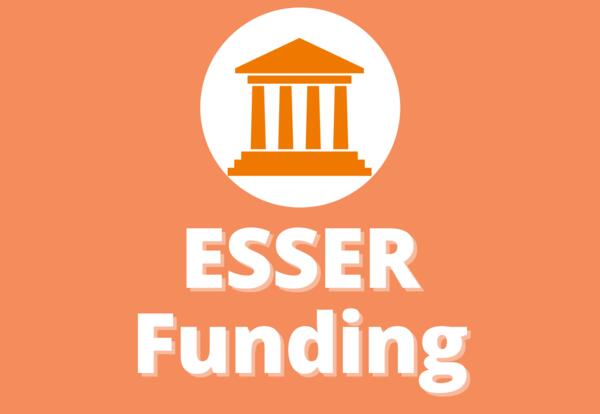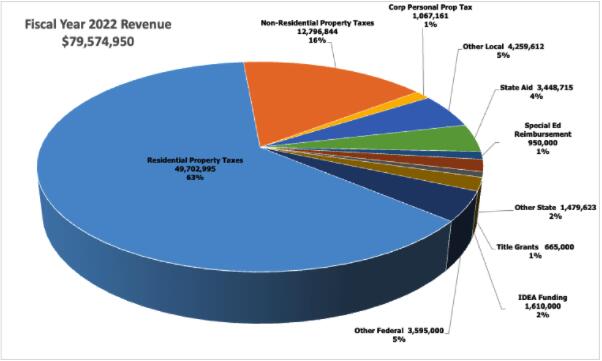
District 58 received the following federal government CARES Act and ESSER (Elementary and Secondary School Emergency Relief) funding to help mitigate the negative impact of the COVID-19 pandemic.
Initial CARES Act (ESSER 1): $247,255
ESSER 2: $835,771
ESSER 3: $1,875,993
District 58 anticipates total revenue for fiscal year 2022 from the state and federal governments in the amount of $5.87 million and $5.85 million, respectively. The ESSER money has significantly increased the amount of total federal funding District 58 has received; typically, federal funding represents a much smaller portion of District 58's overall budget. District 58's revenue budget for fiscal year 2022 is noted here:

How is District 58 using its ESSER funds?
District 58's ESSER funds are being used for the costs incurred and added to its normal operations due to COVID-19.
CARES Act/ESSER 1 funds were used for:
- Technology updates and added purchases of equipment and licenses needed for the 1:1 atmosphere of remote learning
- PPE
- New cleaning supplies
- Tents for mask breaks at each school
ESSER 2 funds were used largely to address the following:
- Staffing and operations last school year in the hybrid format, including staffing for smaller class sizes due to classroom size constraints
- Lunch stipends and added support staff to allow supervision in classrooms as schools were not able to use their normal lunch space
- Furniture for students to be distanced to meet the IDPH standards
- PPE
ESSER 3 were used/will be used for:
- PPE (though this is a much smaller amount needed at this point)
- Furniture needed for new classroom structures with COVID limitations on spacing
- Resources to address learning loss
- Expanded summer school to assist with learning loss (2021 and likely 2022)
- Additional certified interventionists hired
- One homebound coordinator hired to assist with remote learning for students unable to attend in-person school due to medical conditions.
It is District 58's intention to complete the ESSER grants by the end of fiscal year 2023 in order to make the greatest impact on students. Some community members have suggested that these funds be used for capital improvements in lieu of selling the Longfellow property. The District has decided to focus these funds on the impact in the classroom and, specifically for ESSER 3, on addressing any learning loss due to the impact of the pandemic since March of 2020.
How are ESSER funds managed?
The State of Illinois has a very specific grant submission system that school districts must follow. The management of these funds is really no different than the structure used for other federal funds that flow to the District from the federal government. For federal grants, the State is given the limits of the use of federal funds, which are described in the grant application. Federal grants are always paid in a reimbursement format to local governments. Once the District has spent the funds on the approved expenditure, it seeks reimbursement from the State. The State Board of Education staff review and approve the grant based on the federal guidelines they have been given to follow. This is the standard process for any federal funds allocated to school districts.
The District is annually audited by independent auditors who sample and test our systems in accordance with generally accepted accounting principles (GAAP). Those audits and financial reports are filed with the State and posted on the District’s website. We anticipate the presentation of the fiscal year 2021 audit at the December Board of Education meeting.
ESSER money was distributed using the same allocation as Title 1 funds, which is largely based on a school district's low income data. District 58 received a significantly smaller amount of ESSER funds than many other school districts. Some school districts that did receive significant funding could use the money for capital projects, namely HVAC and air handling updates. District 58 does not have such units in most of the buildings, and the cost of installing AC in the District's aging buildings far exceeds the resources in ESSER and any funds the District has on hand for such projects.
The District's financials are posted on the Finance & Transparency page of the District website; in addition, the monthly report that documents year-to-date compared to budget and against a 5-year trend is listed in each board packet. The website also contains audited financials dating back to 2010, the annual statement of affairs back to 2011, and budgets back to 2012. We also note that in the five-year plan, posted on the website, and approved by the Board of Education in April, there is a discussion regarding the impact on the pandemic on both expenditures and revenue.
The District budget process for the current fiscal year 2022 started with an initial presentation in December 2020, and was discussed multiple times both at the Board meetings, but also through the District’s Financial Advisory Committee (FAC), which has met monthly during the pandemic to review and discuss these type of issues and updates through the budget calendar, from initial presentation through audit.
.png?mask=8)